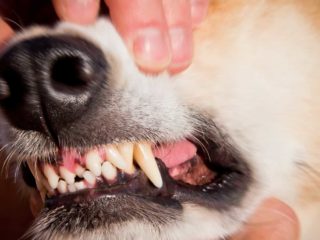A tail can tell us so much about our dog, they are a very beautiful and important trait on our precious Bichon Frise. But what is it about the tail that makes it so special? How do we know if our Bichon Frise has a normal tail, or if something may be off or different?
Well, I was curious about this too so I took some time to Paws and Learn so I could find all the answers to every question you could have about your Bichon Frise’s tail. It’s all referenced here in this article in one easy place.
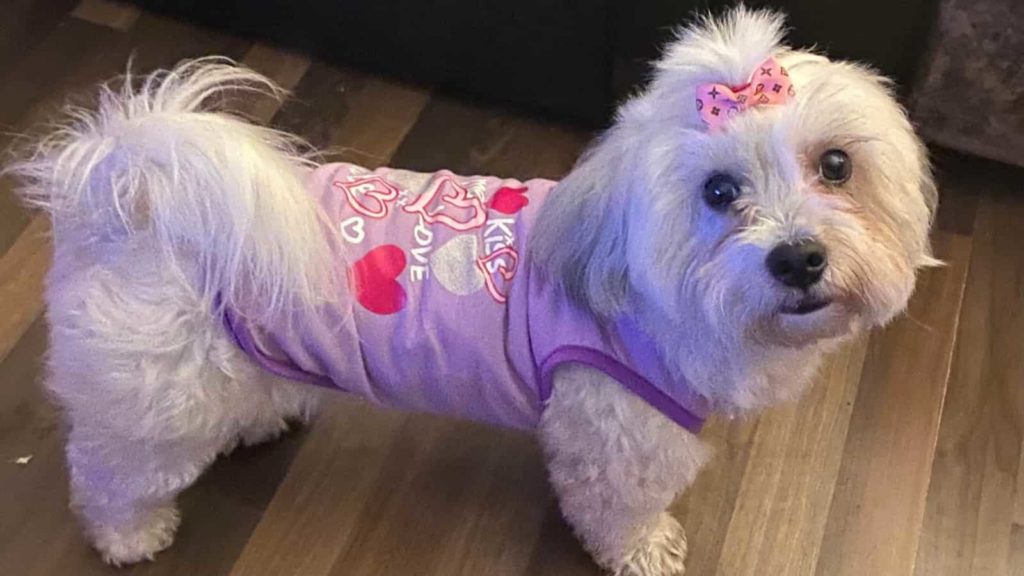
Do Bichon Frises have tails?
Purebred and Bichon Frises mixes do have tails. Your Bichon Frise should naturally have a long tail that has a gentle graceful curve up and over their back. The tip of the tail should rest just to the side of its hind end. If your Bichon Frise or Bichon Frise mix has a very short stub tail then it probably has been docked.
Pro Tip: If you are interested in the best grooming tools for your dog you can find them by clicking here now!
How long are Bichon Frise tails?
Bichon Frise Tails are on average are 5 to 7 inches long. Think about the length and curve of a small banana.
Disclaimer: This post may contain affiliate links. We only recommend high-quality products that are used and recommended by real owners. If you use these links to buy something we earn a small commission.
Do Bichon Frises get their tails docked?
Bichon Frises are not a breed that gets their tails docked. Some Bichon Frise mixes will have their tails docked if the breeder was following the standard for the other breed that your Bichon Frise is mixed with.
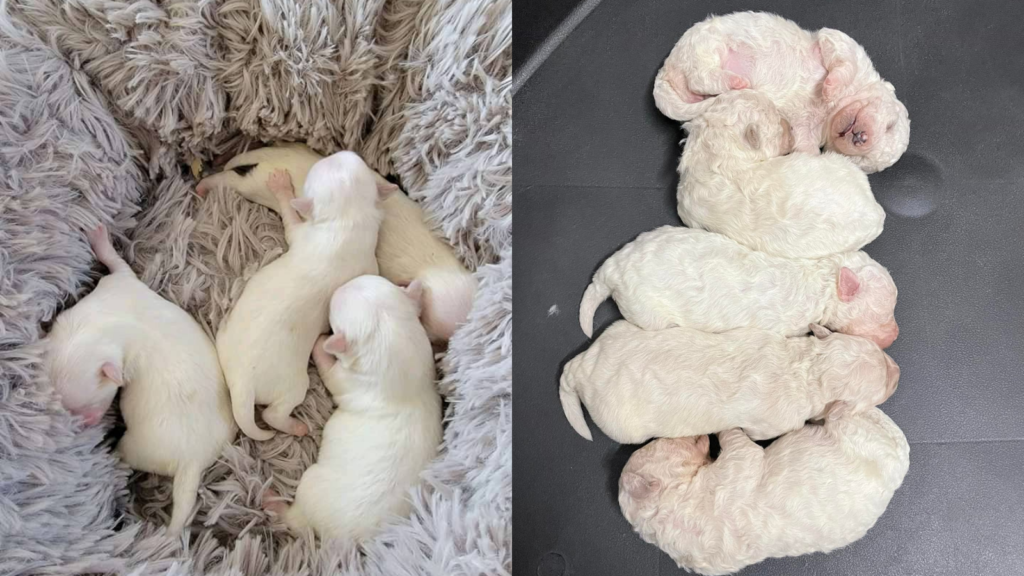
Some small breeds such as the Yorkshire Terrier and poodles will often have their tails docked for aesthetic purposes. These dogs are historically working dogs, they have been bred in the past to do certain jobs. For example, Yorkshire Terriers were bred to catch and exterminate rodents for coal mine workers.
As working dogs, it was safer for these breeds to have shorter tails to prevent them from getting caught or injured in the line of duty. Some owners like to maintain that historical appearance even if their dogs are only bred to be companion dogs.
The AKC (American Kennel Club) has different standards for different breeds. The standard for Yorkies and Poodles are docked tails so breeders who have a desire to follow those standards will most likely dock the tail of their puppies.
There is really no reason to have any Bichon Frise mix puppies get their tails docked as Bichon Frise mixes are not traditionally recognized by AKC, and will have no conforming appearance standards to uphold. Bichon Frise mixes can join AKC Canine Partners Program but are not required to conform to a certain appearance to join.
Do Bichon Frises have curly tails?
Bichon Frises do not have curly tails. Their tails should make an arc from the base of the tail up and over their back. Any tail curling more tightly than that may be considered a flaw in genetics or breeding.
Some Bichon Frise owners have noticed that their Bichon Frise’s tail curls more than normal and almost looks like a pig’s curly tail. If this is the case for your Bichon Frise don’t panic, it shouldn’t cause any problems, but you may want to check with your vet at their next appointment to be sure.
It would also be recommended that you don’t breed your Bichon Frise as this flaw can be passed down to the puppies and become more problematic for each generation going forward.
The one issue some owners have with their Bichon Frise’s curly tail would be that it can make grooming more difficult. Having a curly tail can cause more matting at the base of the tail.
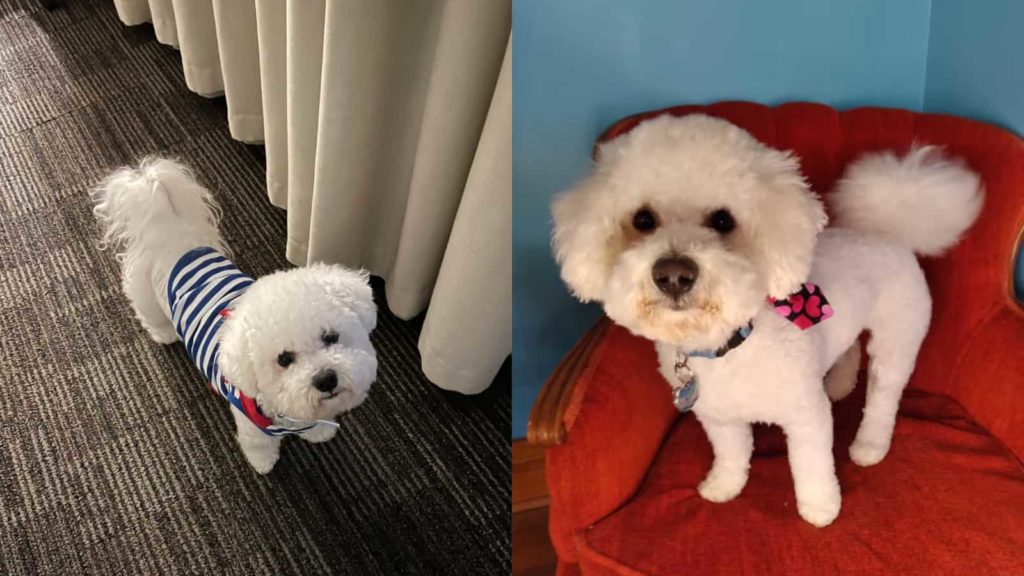
Bichon Frises Tail Wagging and Communication
Bichon Frises wag their tails for many different reasons. It’s a big part of how they communicate with you. Wagging their tail doesn’t always mean they are happy. They could be conveying other emotions like nervousness or fear as well. The key to understanding their tail wags is to put it together with all the other contextual clues they are giving you. What are their ears doing, their eyes, how is their posture? Noticing these things as well will help you know why your Bichon Frise is wagging its tail.
Here are some things your Bichon Frise could be communicating to you with its tail.
- Calm and chill – Tail in the natural resting position. Sleeping or resting or casually walking around.
- Greeting or I love you – Usually, a big carefree wag, accompanied by eye contact, coming to you and jumping on you or trying to get your attention.
- Curious or unsure – Backwards and gentle wagging. Maybe sniffing around a little, intense and curious staring. Looking to you for reassurance.
- I’m nervous or scared – The tail between their legs and possibly slightly moving. Body tense, eyes down, ears laid back. Could also be trying to communicate a submissive position.
- Aggression – Tail high in the air and rigid. Poised, rigid, and making eye contact. Could be barking or growling as well.
- Happy and Excited – Fast care-free wagging. Wiggling body, happy facial expressions. Body not tense, possibly going in circles around the object causing excitement such as a treat or toy.
There’s also been a study done that shows the direction that your dog wags its tail can show positive or negative emotion. Wagging their tail towards the right side of their body can indicate more positive emotions such as relaxed, and happy. Wagging their tails on the left side of their body is a sign of more negative emotions such as nervousness or fear.
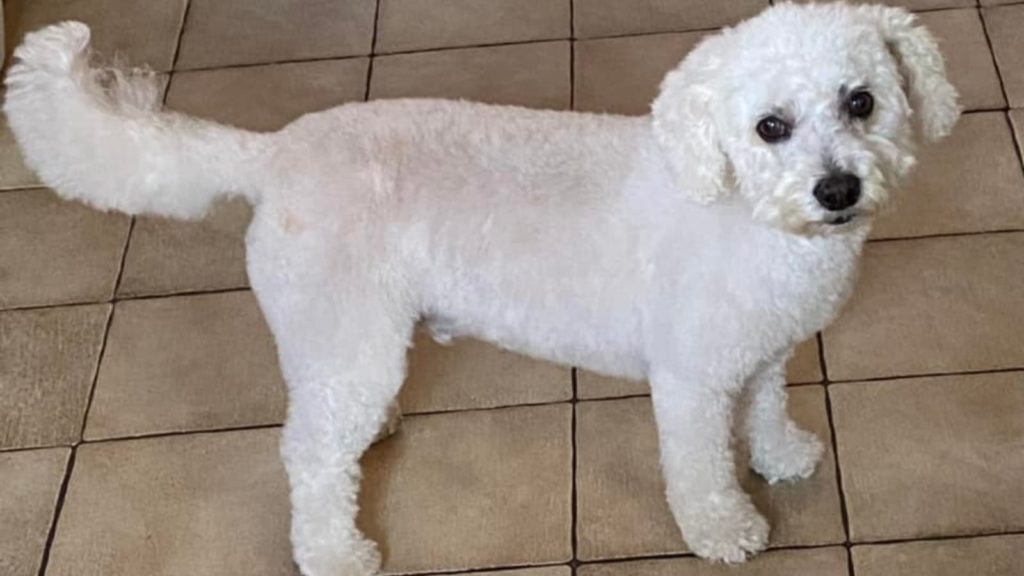
For most Bichon Frises, wagging their tails to communicate is a natural and normal thing for them to do. Occasionally you will find a Bichon Frise that doesn’t wag its tail at all. Don’t worry, you are not alone.
If your Bichon Frise doesn’t wag their tail it’s most likely just part of their personality or genes. It could also be that they have an extra curly tail that makes it more difficult for them to wag, but it could also indicate a medical problem and they should be seen by your vet to rule out any serious issues.
If your Bichon Frise has recently stopped wagging its tail then there could be other factors involved. If you have just moved, or they are new to your home this could just mean they are nervous and need some time to get acclimated to their new environment.
Some dogs are bigger tail-waggers than others. If your Bichon Frise doesn’t wag their tail at all then you will have to learn to identify other body language cues to help you understand what they are trying to tell you.
Bichon Frise Chasing its Tail or Biting its Tail
For the most part, if your Bichon is chasing its tail it’s most likely just a harmless and adorable game. Puppies tend to do this a lot because they are so playful and exploring more about their world and discovering their fun long tails. If your dog is chasing his tail it might be because he’s bored or it’s just a fun game for him.
Trying out a fun training program together like this widely popular program Brain Training for Dogs can help unlock your dog’s hidden potential and help them learn how to avoid problem behaviors.

The problem comes when your dog is obsessively chasing its tail and it seems like they are in pain stressed or biting its tail and causing things like bleeding, or hair loss.
If this is the case then rightfully you are probably concerned.
The cause for this could be one of several things. Here are the things that you can look for.
- Impacted anal glands
- Parasites like fleas or ticks in the tail
- Injury or sharp pain somewhere on the tail
- Allergies or itchy skin
- Boredom and in need of more exercise
Why is My Bichon Holding its Tail Down?
If your Bichon Frise is constantly Holding his tail down or it seems to be in a down position more often than the normal resting position this could indicate a problem called Luxating Patella.
This really is just a fancy way to stay a misplaced knee cap. Besides the tail, another indication this may be the problem is if you notice your dog stretching out their rear limbs and walking in circles. Luxated Patella is a common problem for small breeds and often will self-correct after a few days or rest and stretching.
If it seems to be causing your dog a lot of pain or the problem is not going away it’s best to take your dog to the vet. They will assess the situation and if this is a recurring problem for your dog may recommend surgery to fix the problem. If surgery is performed it should be a permanent fix for your dog.
How to Groom Bichon Frise tails
Most of the time a Bichon Frise’s tail is left full and uncut. Part of their charm is the gorgeous plume flowing from their rear end. This does require daily or at the least bi-weekly brushing. This brush works really well for keeping the mats away on long hair dogs like Bichon Frises. If your Bichon Frise does get mats in their tail it may be necessary to trim the tail, or possibly thin it out a little bit.
Here is a video that has tips on helping with the matting on your Bichon Frise’s tail.
Hair Loss on a Bichon Frise Tail
There are several reasons that your Bichon Frise may be losing hair on its tail. We will discuss a few, but it’s important that you consult your dog’s vet to get a professional medical opinion.
- Atopy – Environmental or food allergies that cause hair loss on the tail and other parts of your dog. Could be seasonal. You may want to treat it with antihistamines prescribed by your vet.
- Mange– a parasitic skin disease caused by microscopic mites. Look for patches of fur missing and a lot of itching. Many cases will clear up on its own, more severe cases should be treated by a vet.
- Fleas – Very tiny wingless insects that will bite and feed off of your dog. Look for small red bumps on your pet’s skin. Fleas may irritate your dog enough that he will be biting or scratching so much his fur starts to come off.
- Hormonal Problems – Cushing’s disease or hypothyroidism can cause hormonal imbalances that may cause hair to fall out. If your dog is not biting or scratching their tail but they are still losing hair this may be the cause. Watch for a tired or lethargic dog. This can be treated with medication or surgery. Consult your vet.
- Old age– If your Bichon is a senior (9-12 years old) hair loss on their tail may be caused by aging. If this is the case you can do your best to help them feel comfortable and make sure that they are not in any pain.
Pro Tip: If you are not able to get a hold of a vet near you, or you want to avoid an unnecessary ER trip, there are online resources that you can turn to. Here is our best recommendation:
Pawp: a 24/7 digital clinic for pets that connects you to an experienced vet
Why we love it:
🐾 Answers 24/7! 🐾 No waiting! 🐾 Get Answers Online with Local Vets! 🐾 Quick Response Time! 🐾 Easy Sign UP!
Try Pawp 7 Days For Free
Other Tips for Bichon Frise Tails Problems
How to Keep Poop From Sticking to your Bichon Frise Butt
This can be a common smelly problem for long hair dogs. If it happens often and doesn’t get taken care of it can also lead to serious health issues as well.
Here are some tips to keep your fur baby’s fluffy rear end clean.
- Keep the hair near their rear clean and trimmed.
- Keep wipes handy to clean it out right away.
- Add more fiber to your dog’s diet.
- Check for infections or parasites such as worms.
Bichon Frise Tail Infection (Tail Tip Necrosis)
This is a very serious problem, but thankfully very rare in Bichon Frises. It can be important though that you learn to identify it right away so the issue can be dealt with before it causes permanent damage.
This can be caused by the constant beating of the tail against objects that may harbor bacteria. If the tail gets an open wound and the bacteria gets in it can lead to an infection that will spread and cause the tissue to become damaged or start dying.
Watch for hair loss at the end of the tail. Excessive itching, bloody or brittle skin, foul-smelling, excessive biting or the tail.
Take your dog to the vet right away if you notice any of these things in your dog. The vet will assess and most likely have to amputate the infected part of the tail. This may be a very sad thing to have to deal with, but if the infection spreads it could endanger your dog’s life.
While we strive to give the most accurate and helpful information about your pet’s health that we can, this article is meant to be informational only and not medical advice. Never disregard, avoid or delay in obtaining medical advice from your veterinarian or other qualified veterinary health care provider regardless of what you have read on this site or elsewhere.



